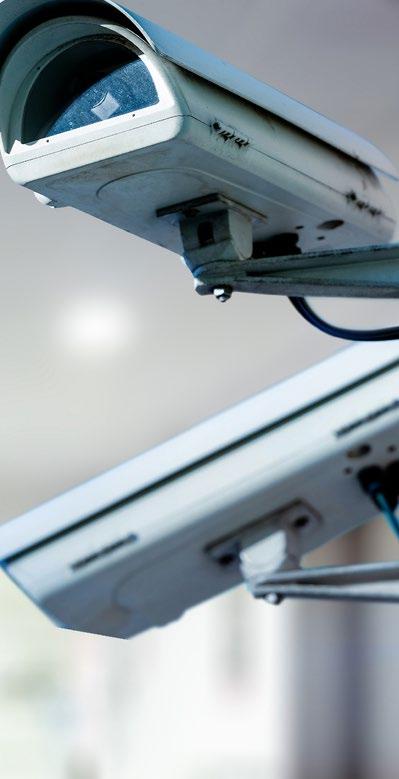
5 minute read
Video and Audio Surveillance in The Workplace
A Balance of Rights
By Jessie Taylor
Video and audio surveillance in the workplace is an increasingly common practice used by employers to monitor employee behaviour, ensure security, and prevent misconduct. However, while surveillance can be a useful tool, it also raises important legal and ethical considerations. Employers must balance their need to protect company interests with their employees’ rights to privacy.
Employers often face challenges when proving employee misconduct at the Commission for Conciliation, Mediation and Arbitration (CCMA) and bargaining councils. The burden of proof lies entirely on the employer to establish that a dismissal was fair. Many employers rely on video evidence to strengthen their cases, believing that visual proof of wrongdoing, such as theft, guarantees a favourable ruling. However, this is not always the case.
While the CCMA and courts have accepted video evidence in certain cases, there have been instances where such evidence was rejected. Factors that influence the admissibility of video evidence include:
The clarity of the footage
The authenticity of the recording
The relevance of the footage to the specific incident
Whether the recording contradicts other evidence
Compliance with legal restrictions on surveillance
While video evidence can be useful, it is not automatically admissible. Employers must ensure compliance with evidentiary and privacy laws to use surveillance footage effectively.
In South Africa, workplace surveillance is subject to various legal provisions, including:
The Constitution of South Africa, 1996 – Protects an individual’s right to privacy.
The Regulation of Interception of Communications and Provision of Communication- Related Information Act (RICA), 2005 – Restricts the unauthorized interception of communications.
The Protection of Personal Information Act (POPIA), 2013 – Governs the lawful collection, processing, and storage of personal data, including surveillance recordings.
Employers must inform employees of surveillance measures and ensure that monitoring does not infringe on their rights. Failure to comply with these legal requirements may render surveillance footage inadmissible in legal proceedings and expose employers to legal action.
Employers do have certain obligations when installing surveillance in the workplace.
Employers must ensure that employees are fully aware of the surveillance policies. Clear communication is vital to avoid misunderstandings. Surveillance should be explicitly outlined in employment contracts, as part of employee handbooks, and prominently displayed in the workplace through notices or signage.
Surveillance should only be implemented for legitimate business purposes. Employers must justify why surveillance is necessary, ensuring it aligns with business needs such as security, employee safety, theft prevention, or regulatory compliance. Surveillance mustn’t extend beyond what is reasonable for the business’s objectives.
Employers must respect employees’ privacy in spaces with a reasonable expectation of privacy, such as restrooms, changing rooms, and break areas. Surveillance in these spaces is typically intrusive and can result in legal repercussions. The general rule is that cameras should be placed where employees’ private activities will not be unnecessarily exposed.
Transparency is essential in ensuring that employees understand the purpose of surveillance and how it affects them. Employers should outline the types of surveillance used (e.g., CCTV, computer usage monitoring), the reasons for monitoring, and how long footage will be retained. Clear procedures should be in place regarding who has access to recorded data and how it is stored and protected from unauthorized access.
It is crucial that video and audio recordings are clear, accurate, and tamper-proof to ensure that they can be used as reliable evidence if needed. Employers should have policies to ensure footage is stored securely and that any access to the data is logged and monitored. Additionally, employers should use technology that prevents footage from being altered or tampered with.
While employers have the right to implement surveillance, recourse is available to employees who feel their rights have been violated.
Employees can directly express concerns about workplace surveillance to management or the HR department. The employer should provide a mechanism for addressing such concerns.
If an employee feels that their rights have been violated by improper surveillance or that the monitoring is unjustified or excessive, they can consult a labour law professional.
In cases where surveillance leads to a breakdown in trust between employer and employee, such as where the employee feels unfairly monitored, they may be able to claim constructive dismissal.
Under South Africa’s Protection of Personal Information Act (POPIA), employees are entitled to privacy and the protection of their personal information, including video and audio recordings made in the workplace. Employees have the right to complain with the Information Regulator if an employer collects or processes personal data unlawfully.
Video and audio surveillance can be a powerful tool for employers, but it must be used responsibly and within the boundaries of the law. Employers should prioritize transparency, compliance, and fairness when implementing surveillance systems to avoid legal disputes and maintain a positive workplace environment.
On the other hand, employees should be aware of their rights and take action if they feel their privacy is being infringed upon. A well-balanced approach ensures that workplace surveillance serves its intended purpose without undermining trust and employee well-being. Source: Labour Guide | Legal Leaders











